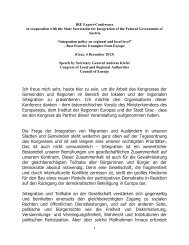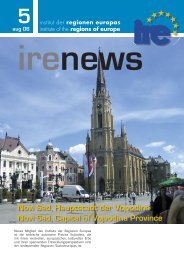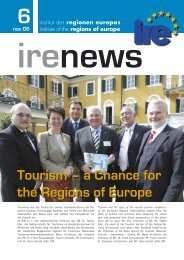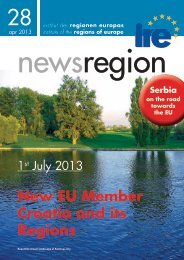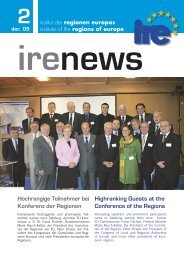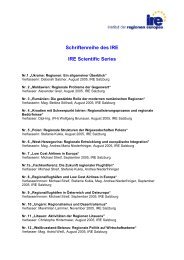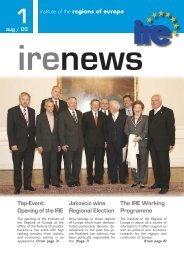8th Conference of European Regions and Cities - Institut IRE
8th Conference of European Regions and Cities - Institut IRE
8th Conference of European Regions and Cities - Institut IRE
You also want an ePaper? Increase the reach of your titles
YUMPU automatically turns print PDFs into web optimized ePapers that Google loves.
NUR 10 TAGE!<br />
EU-membership is a big<br />
challenge <strong>and</strong> a big chance<br />
S TAg E E NTERTAINm ENT TouRINg PR o D ucTIo NS<br />
9. - 20. Jan. '13<br />
KINDER ZAHLEN DIE HÄLFTE<br />
Über 1 Million Gäste besuchen jährlich die rund 500 Veranstaltungen<br />
in der Wiener Stadthalle. Ein Erfolg, der auch auf der Vielseitigkeit<br />
und der Multifunktionalität der Arena beruht. Vom Rockkonzert<br />
bis zur Oper, von Holiday on Ice bis zu Masters <strong>of</strong> Dirt.<br />
Seit fünf Jahrzehnten beherbergt die Wiener Stadthalle jene Ereignisse<br />
und Events, die Wien ein attraktives und vielfältiges Unterhaltungsprogramm<br />
garantieren. Ob als Schauplatz von Konzerten<br />
(mit bis zu 16.000 Besuchern in der großen Halle D oder bis zu<br />
2.000 Besuchern in der Showbühne/Halle F) oder Sportereignissen<br />
- darunter bisher rund 80 Welt- und Europameisterschaften. Die<br />
Wiener Stadthalle ist Österreichs erste Adresse für große Stars, große<br />
Shows und große Gefühle!<br />
© Foto Gisela Erlacher<br />
„Croatia cannot rest on its laurels. On the contrary:<br />
A lot <strong>of</strong> work is waiting for Croatia in the next year,<br />
also for the authorities at regional <strong>and</strong> local levels“<br />
underlined Franz Schausberger, president <strong>of</strong> the <strong>Institut</strong>e<br />
<strong>of</strong> the <strong>Regions</strong> <strong>of</strong> Europe <strong>and</strong> Member <strong>of</strong> the<br />
Committee <strong>of</strong> the <strong>Regions</strong> at the Europe Information<br />
Day in Šibenik. At this conference, which was organized<br />
by the Šibenik-Knin County on 16 th May <strong>and</strong><br />
hosted by the County Prefect Goran Pauk, Schausberger<br />
spoke about „EU Accession <strong>of</strong> Croatia <strong>and</strong> the<br />
Croatian <strong>Regions</strong>“.<br />
Schausberger stressed out that many reforms still<br />
have to be done in Croatia. The necessary reforms af-<br />
The st<strong>and</strong>ard <strong>of</strong> living in Zagreb is currently „only“ 25 percent<br />
lower than the EU average, compared with 50 percent<br />
on the coast <strong>and</strong> as much as 70 percent in eastern<br />
<strong>and</strong> central Croatia.<br />
Croatia currently consists <strong>of</strong> twenty-one counties, 127 towns<br />
with over 10,000 inhabitants <strong>and</strong> 429 municipalities. Croatia is<br />
now divided into three statistical regions at the NUTS 2 level -<br />
Northwestern, Pannonian <strong>and</strong> Adriatic Region. There are some<br />
ideas to create three larger political regions by merging several<br />
counties. Schausberger expressed his opinion that this is neither<br />
necessary nor useful. A better recommendation is to give<br />
the counties better (legal) instruments <strong>and</strong> a stronger support<br />
for cross-border regional cooperation.<br />
In this spirit further efforts are needed to reform public administration<br />
at local <strong>and</strong> regional levels in order to strengthen the<br />
capacity, efficiency, independence <strong>and</strong> reliability <strong>of</strong> administration<br />
at all levels. Regional <strong>and</strong> local administrations must<br />
be comprehensively involved into the <strong>European</strong> integration<br />
process <strong>and</strong> EU cohesion policy. It is necessary to train <strong>and</strong> prepare<br />
administration employees <strong>and</strong> regional <strong>and</strong> local politicians<br />
to enable regions <strong>and</strong> municipalities for developing projects<br />
suitable for EU fund support that will be available within<br />
the Cohesion Policy after accession.<br />
The authorities <strong>of</strong> Šibenik-Knin, on the top Župan Goran Pauk,<br />
are intensively interested in <strong>European</strong> affairs in benefit <strong>of</strong><br />
Šibenik-Knin County. Šibenik-Knin was <strong>and</strong> is involved in several<br />
<strong>European</strong> programmes as CARDS, INTERREG, PHARE, ISPA<br />
<strong>and</strong> IPA. At the moment Šibenik-Knin region has applied for<br />
IPA for seven projects in the field <strong>of</strong> business infrastructure for<br />
6,2 million Euro.<br />
After the accession to the <strong>European</strong> Union next year, the Croatian<br />
regions <strong>and</strong> cities will have their representatives in the<br />
Committee <strong>of</strong> the <strong>Regions</strong> <strong>of</strong> the EU. Croatia will be entitled<br />
to send its nine-member delegation, consisting <strong>of</strong> county prefects<br />
<strong>and</strong> mayors.<br />
For the first time, representatives <strong>of</strong> Croatian local authorities<br />
took part as observers in the 94 th plenary session <strong>of</strong> the Committee<br />
<strong>of</strong> the <strong>Regions</strong>, taking place in Brussels on 15-16 February.<br />
Šibenik-Knin County is a special <strong>European</strong> region. Šibenik, as<br />
the regional capital <strong>of</strong> the county, is a historic town <strong>and</strong> the<br />
political, educational, transport, industrial <strong>and</strong> tourist center.<br />
Unlike other cities along the Adriatic coast, which were established<br />
by Greeks, Illyrians <strong>and</strong> Romans, Šibenik was founded<br />
by Croats. For the first time it was mentioned under its present<br />
name in 1066 in a Charter <strong>of</strong> the Croatian King Petar Krešimir<br />
IV. The Ottoman Empire never succeeded in conquering the<br />
city.<br />
ter the accession will bring a lot <strong>of</strong> problems <strong>and</strong> challenges<br />
but also many chances. The citizens should be<br />
informed very frankly that Croatia‘s EU membership<br />
will not solve all the internal failures.<br />
The existing Croatian regional divisions show big differences<br />
in population <strong>and</strong> economic performance.<br />
For example, the city <strong>of</strong> Zagreb, which is the largest<br />
regional division, has around 770,000 inhabitants<br />
while the smallest, Lika-Senj, has less than one tenth<br />
the number <strong>of</strong> inhabitants <strong>of</strong> Zagreb. The economic<br />
disparity is even greater: the per capita GDP in<br />
Zagreb is around three times as high as that <strong>of</strong> Brod-<br />
Posavlje, the poorest Croatian region.<br />
The fall <strong>of</strong> the Republic <strong>of</strong> Venice in 1797 brought Šibenik under<br />
the authority <strong>of</strong> the Habsburg Monarchy for 120 years. After<br />
World War I, Šibenik became Italian until 1921 <strong>and</strong> then a<br />
part <strong>of</strong> the Kingdom <strong>of</strong> Serbs, Croats <strong>and</strong> Slovenes. After WWII<br />
it became a part <strong>of</strong> Yugoslavia until Croatia declared independence<br />
in 1991. During the Croatian War <strong>of</strong> Independence<br />
(1991-1995), the people <strong>of</strong> Šibenik managed to defend the city.<br />
Architecturally, the damaged parts <strong>of</strong> the city have been fully<br />
reconstructed. The central church in Šibenik, the Cathedral <strong>of</strong><br />
St. James, is on the<br />
UNESCO World Heritage<br />
list. So County<br />
<strong>and</strong> City have an<br />
old <strong>European</strong> background.<br />
During the<br />
centuries the region<br />
took over many<br />
different historical<br />
influences <strong>and</strong> today<br />
it is a real <strong>European</strong><br />
region.<br />
Franz Schausberger,<br />
the Zupan<br />
<strong>of</strong> Šibenik-Knin,<br />
Goran Pauk, <strong>and</strong><br />
Bernd Petrisch,<br />
Member <strong>of</strong> <strong>IRE</strong><br />
Advisory Board<br />
12 newsregion 25 / july12 newsregion 25 / july12<br />
13



